What is an inventory spreadsheet template?
An inventory template is a spreadsheet with an itemized list of every product your business has in stock. It is used to record inventory levels and track inventory turnover.
Products, in this case, can be anything – raw materials, work-in-progress, equipment or finished goods. It may not only be something your company sells but also stuff your company uses, such as laptops, software, or even work suits.
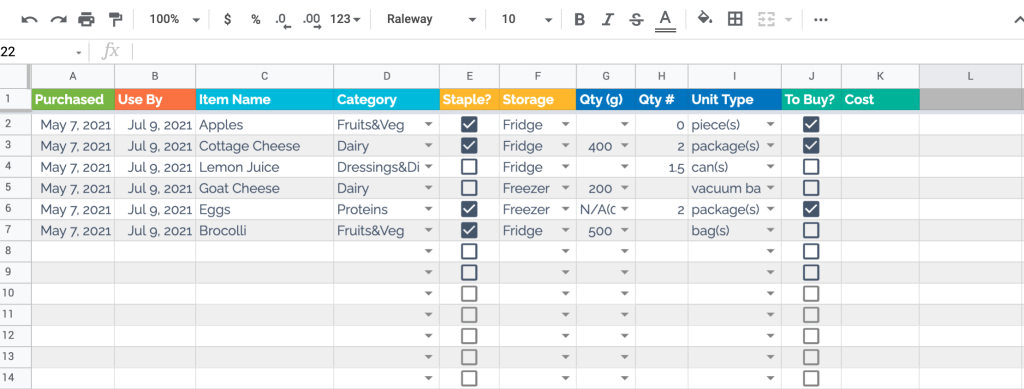
Accurate, real-time stock information helps you get clear visibility of your stock and make the right top-level business decisions. Here is where an inventory template can come in handy because a detailed input of all your inventory will ensure a bullet-proof check-up of inventory status and value.
Free inventory templates in Google Sheets
We’ve prepared 15 spreadsheet templates for inventory management that you can use for free. Pick the one that meets your needs and populate it with your data either manually or using one of the Google Sheets integrations by Coupler.io.
1. Retail inventory Google Sheets template
If you are in retail, whether offline or online, inventory management is at the heart of your business, one way or another. Without it, you won’t be able to provide sufficient customer experience, improve cash flow, and grow your company. Here is a simple Google Sheets inventory template with pre-filled information and some basic formulas to show the power of inventory tracking. It is done in the form of a workbook with three tabs.
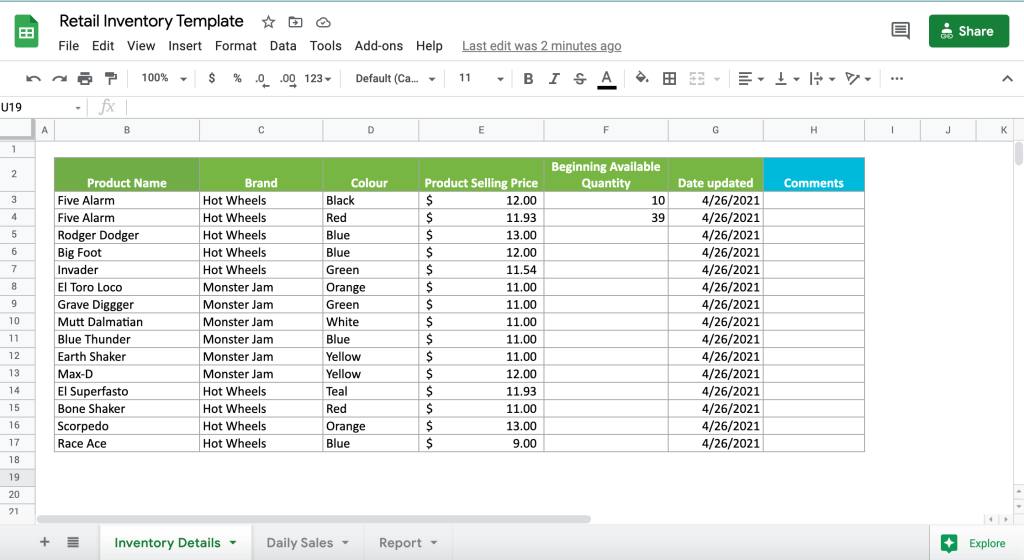
The first tab – Inventory Details – contains Product Name, Brand, Colour, Product Selling Price, Beginning Available Quantity, and Date Updated. You can also include comments as they help jog your memory of product details or your conclusions on some deals. The first tab serves more like a database of all inventory available.
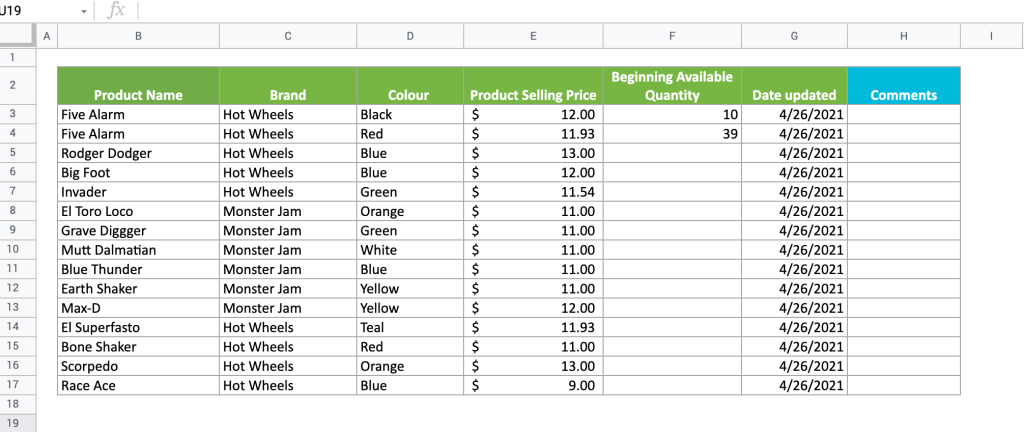
The second tab should be used to track your daily sales. To simplify manual input, we included a drop-down list of all the products. Product Price pulls in automatically. This is made possible due to the formula:
=IFNA(INDEX('Inventory Details'!$B$3:$G$17,MATCH('Daily Sales'!$C4,'Inventory Details'!$B$3:$B$17,0),4),"")
Product Final Price is also calculated automatically.
=(D4*E4)-F4
The tab also contains Order Date, Quantity Sold, Discount (if any), and Comments.
The Report tab shows consolidated data on your sales and enables getting reports over a certain period.
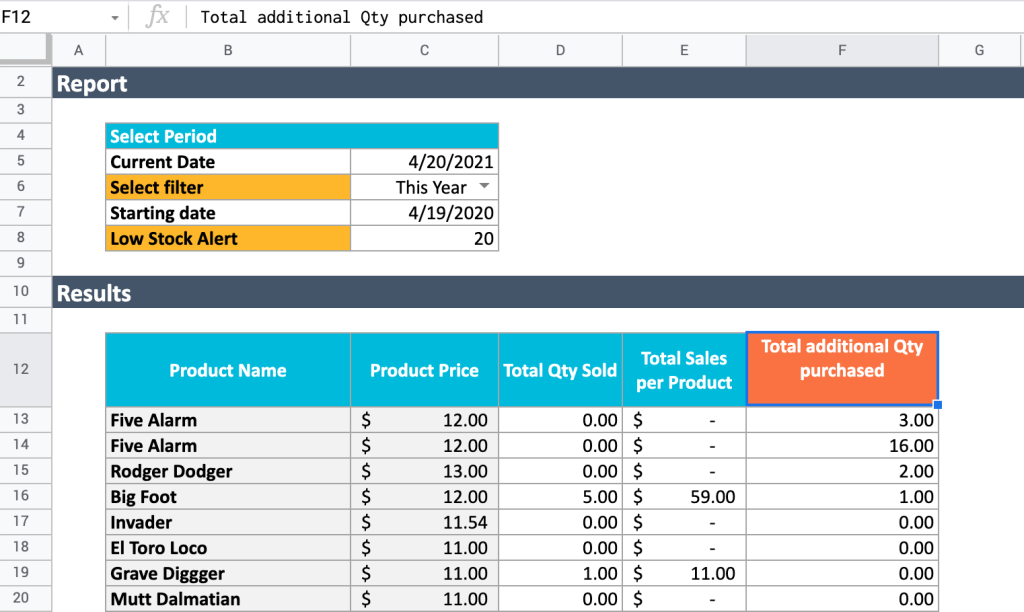
Again, to make life easier, we used some formulas like SUMIF function Google Sheets.
2. Barcode inventory Google Sheets template
For some businesses, the ability to scan your barcode is a real helping hand. Google Sheets does not have it as a built-in feature, but some solutions can help you turn your Google Sheets into an inventory management app. For example, AppSheet will enable you to capture and scan your barcode to record your stock in and out. It can also calculate your current stock and even show all items that need restocking in a separate view. Another cool feature of the app is sending you email alerts, such as when the product expires or needs to be reordered soon.
To use the app, you need to:
- Get the AppSheet add-on.
- Structure your spreadsheet data and define column types so that the app presents it correctly and doesn’t turn everything upside down.
- Launch the add-on and press GO!
There you have it: a beautiful view in the app and real-time data sync with the backend spreadsheet. The only thing left is to customize the settings and view to get the most out of the app. To be able to add new products to your stock, you’ll need to use the camera on your mobile device to capture the barcode. You can find a more detailed description of this feature and its setup in this blog post.
And here is a simple template you can use to create your app if you choose to.
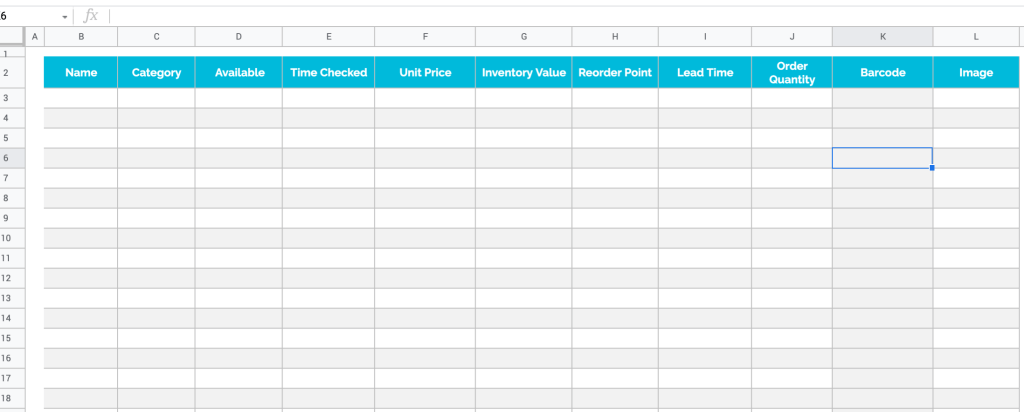
3. Raw materials (manufacturing) inventory Google Sheets template
Raw materials inventory is the total cost of all the parts the business has in stock but has not used yet in production. The two types of raw materials are usually defined as Direct Materials (DM) and Indirect Materials (IM).
- Direct Materials are components that are part of your final product: leather, silk, wood, etc.
- Indirect Materials are components that are not part of your final product but are consumed during the manufacturing process: glue, oil, cleaning supplies, disposable tools, etc.
Our raw materials inventory template is designed for small manufacturers and can be used for both types of raw materials. You can use this manufacturing inventory template to automatically tell you if you need to order more material now or not with the help of the formula:
=IFERROR(IF('RAW MATERIALS'!$E2<='RAW MATERIALS'!$C2,"YES","NO"),"")
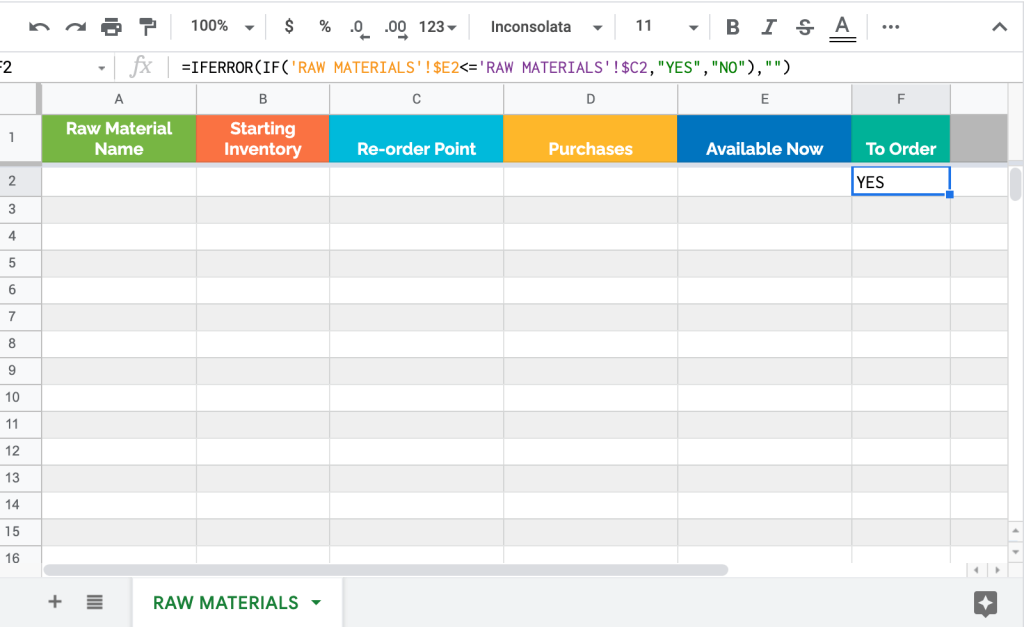
In most of our templates, we use so-called “zebra lines”. They help increase the spreadsheet’s readability and give it a more professional look. Read our blog post about Conditional Formatting in Google Sheets to learn how to highlight alternate cells,
4. Restaurant inventory spreadsheet template in Google Sheets
When people open restaurants, they want to cook great food for great people and earn great money for doing so. They definitely do not want to sit at their laptops manipulating different spreadsheets around the clock. But no restaurant business can do without restaurant inventory. And though this is far from being the most glamorous part of managing a restaurant, restaurant managers need to ensure that they have the right ingredients for every dish on the menu, that those ingredients are fresh, and that no food is wasted. This will let you have your customers satisfied and the budget well managed.
With our Google Sheets restaurant template, you will:
- Know what food you have in stock.
- Identify what raw ingredients you need to buy.
- Estimate the number of ingredients you need to buy.
- Check the quality of the raw ingredients.
- Make a list and create a budget to buy the necessary items.
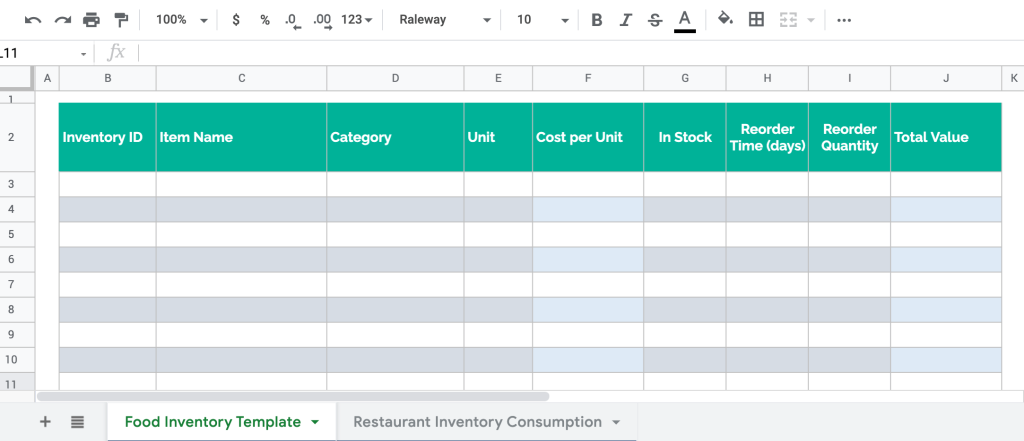
We recommend always inputting inventory ID, though it may seem needless at first glance. But, in the future, it can prevent confusion in your reports. You may have different types of cheese, for example, and using an inventory ID for each type will keep your data clean.
5. Restaurant inventory order template in Google Sheets
If you want to go further, you can easily create your restaurant inventory order template. This will eventually make you aware of how much food you’re wasting, how much of each product is used per day, and how much you’re spending on inventory.
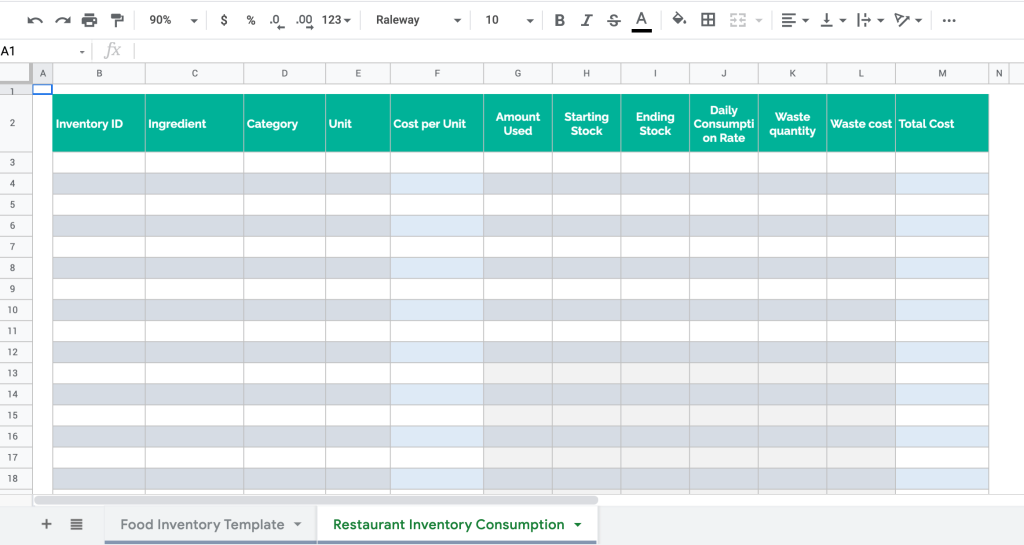
6. Simple food inventory template in Google Sheets
Following the restaurant inventory template pattern, you can create a template to manage your household food inventory. For faster input, it would be a great idea to create checkboxes and pre-filled drop-down lists for some columns. Check out our template to see how it works.

7. Home inventory Google Sheets template
Inventory management can become beneficial even for household management. Tracking your home inventory lets you stay organized and plan your expenses better. It may be applicable when you move house or relocate to a different country, arrange household items sales, need to list your home property in one place for insurance purposes, or simply want to jog your memory on warranties or have a database of user manuals.
The home inventory spreadsheet may include some of the common locations and items. Also, it may also be helpful to add the date, price of purchase, and current value. Taking photos or videos of your home property for your inventory list can make working with your insurance company a lot smoother and be a real time-saver if you want to sell something.
It also can’t hurt if you spend some time adding links to online user and repair manuals.
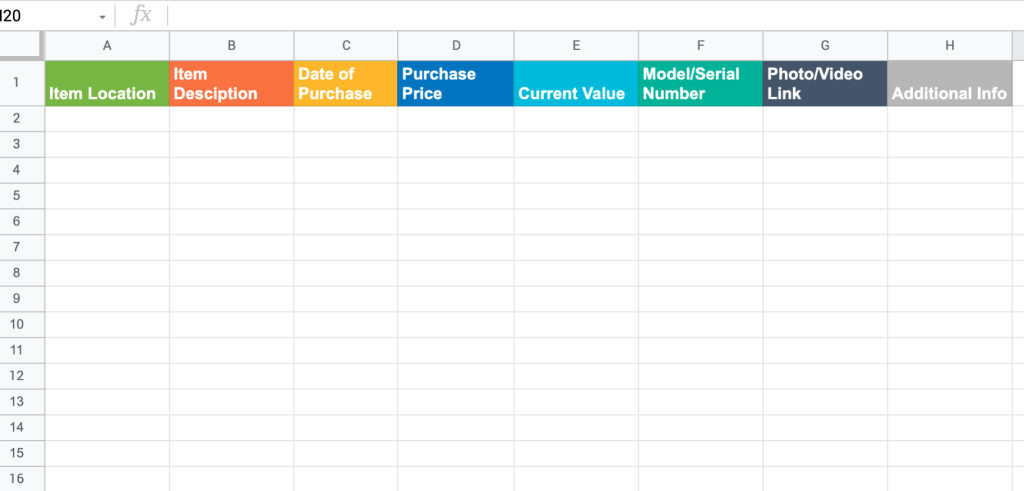
8. Pantry Google Sheets inventory template
One more Google Sheets inventory template you can take advantage of is the pantry inventory list. It is more like a combination of home and food inventory and can be used for both commercial and household purposes.
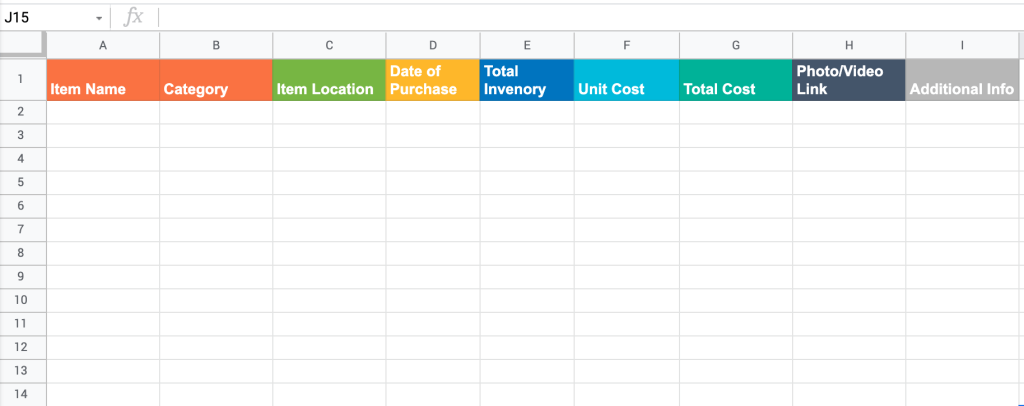
9. Athletic equipment inventory template in Google Sheets
Just as hotels and restaurants keep food and pantry inventory lists, gyms, and sports clubs may want to track their equipment.
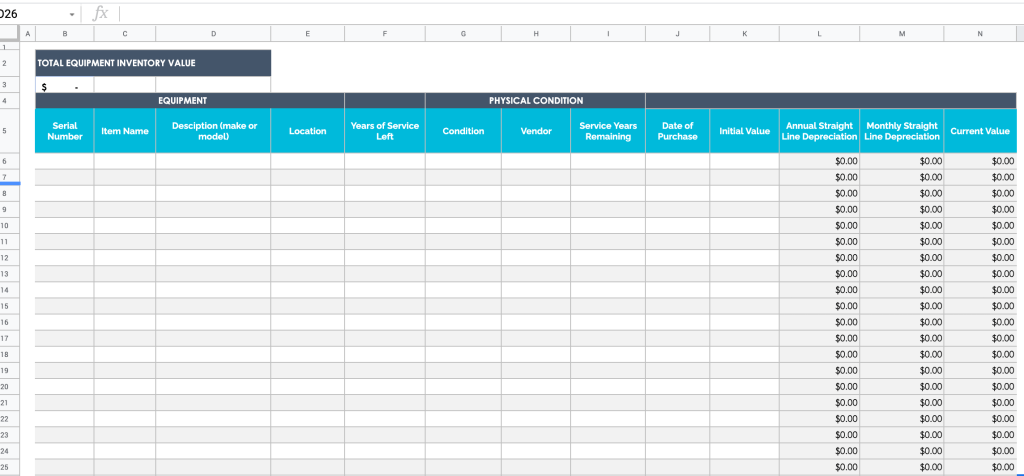
You may also want to add some columns to this template if your athletic equipment is being leased.
10. Vehicle inventory Google Sheets template
Google Sheets vehicle inventory templates are often used by car dealership employees to document unit-specific data and later use it for reference purposes. Our template can be customized depending on what your potential buyer may want to see.
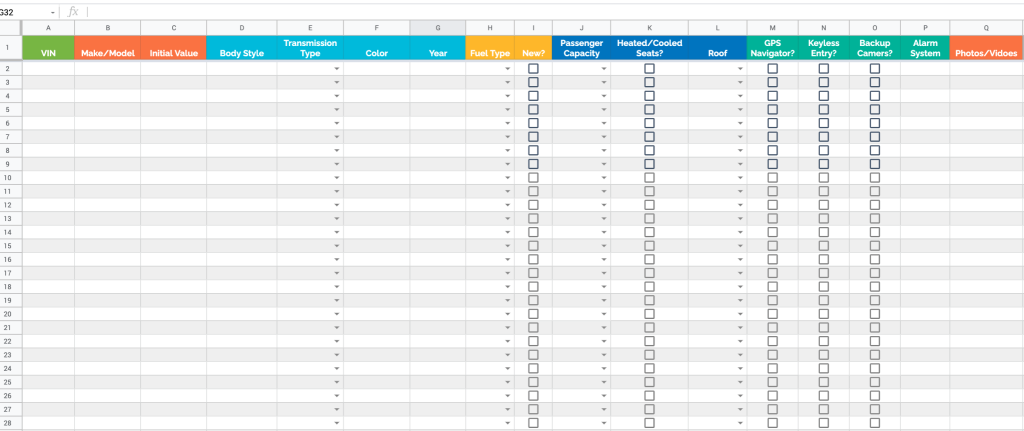
11. Chemical inventory template in Google Sheets
Many employers are required to create a chemical inventory list of all hazardous chemicals present in the workplace. Employees, in turn, should have easy access to this list and be able to find information on chemical hazards, properties, first aid, personal protective equipment, emergency procedures, and disposal methods.
In our template, we included some categories of chemicals, such as:
- Aerosol products
- Compressed gases
- Flammables and combustibles
- Oxidizers
- Organic peroxides
- Poisons not included in the above categories
- Corrosives
- Controlled substances
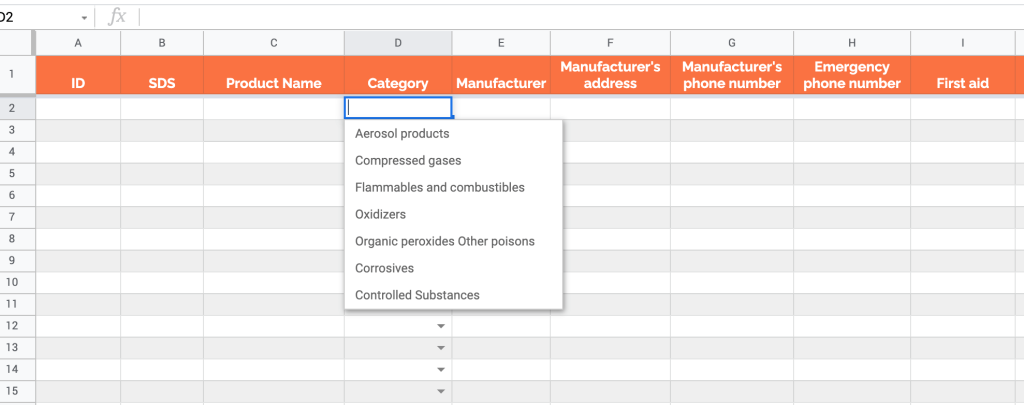
12. Music inventory template for Google Sheets
One more useful template (at least we think so) is a music inventory template. It can be beneficial for schools, churches, theatres, nightclubs, and just plain music fans.
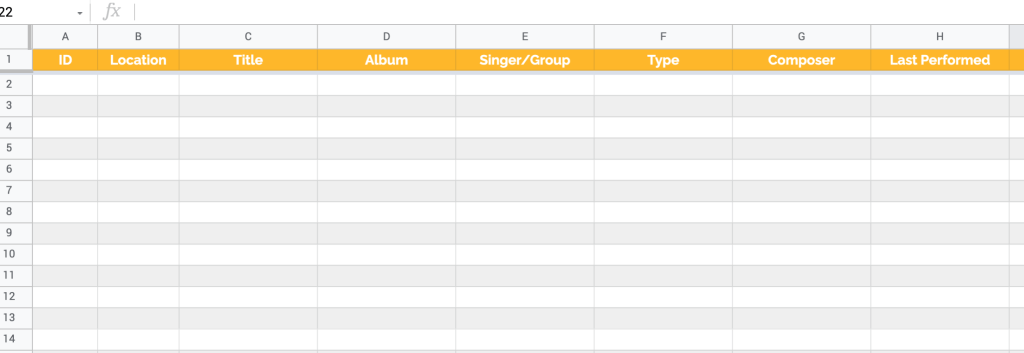
13. Photography inventory template in Google Sheets
With advanced cameras on smartphones and in the Instagram epoch, photography is so accessible that it has become a problem where and how to store the photos. To better understand your photo scope, you can use our inventory template. This will help you not only organize your digital photo collection but also declutter it (poor-quality photos and duplicates).
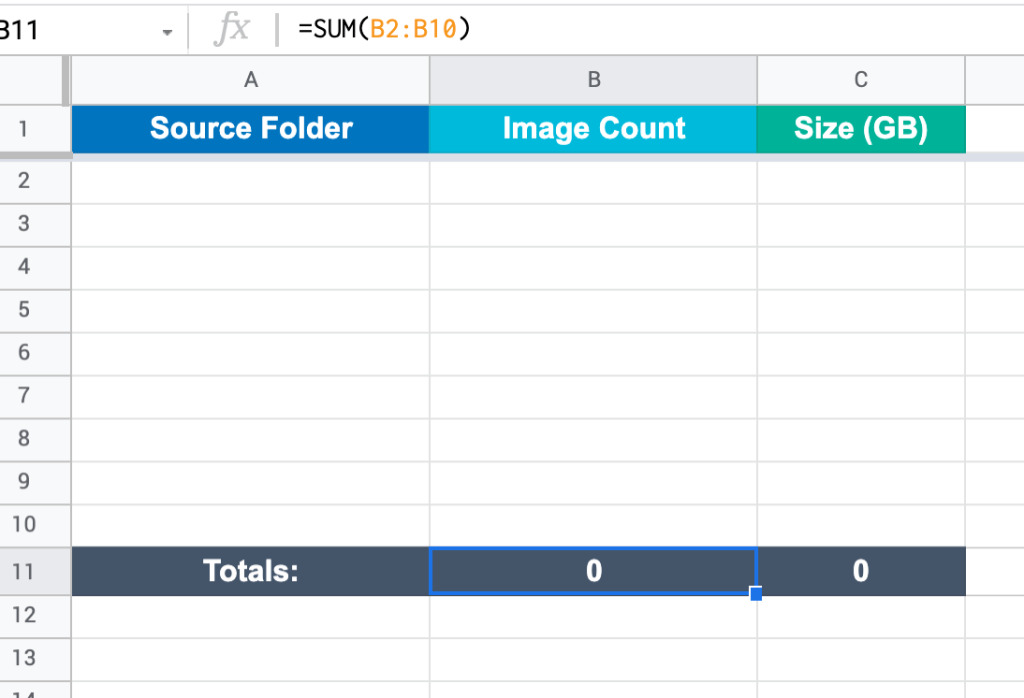
We also included the SUM formulas to calculate Totals =SUM(B2:B10) and =SUM(C2:C10)
14. Classroom inventory template in Google Sheets
Classroom inventory management is one of the most valuable processes for organizing classroom activities and not getting lost in the myriad of materials and equipment.
An inventory can be used in education to monitor classrooms, books, equipment, materials, homework, and many other things. For example, it can be a classroom equipment inventory (computer units, chairs, desks, tables, etc.), books, or resources for indoor and outdoor activities.
Here is an example of an outdoor classroom resource inventory template with some of the predefined categories.
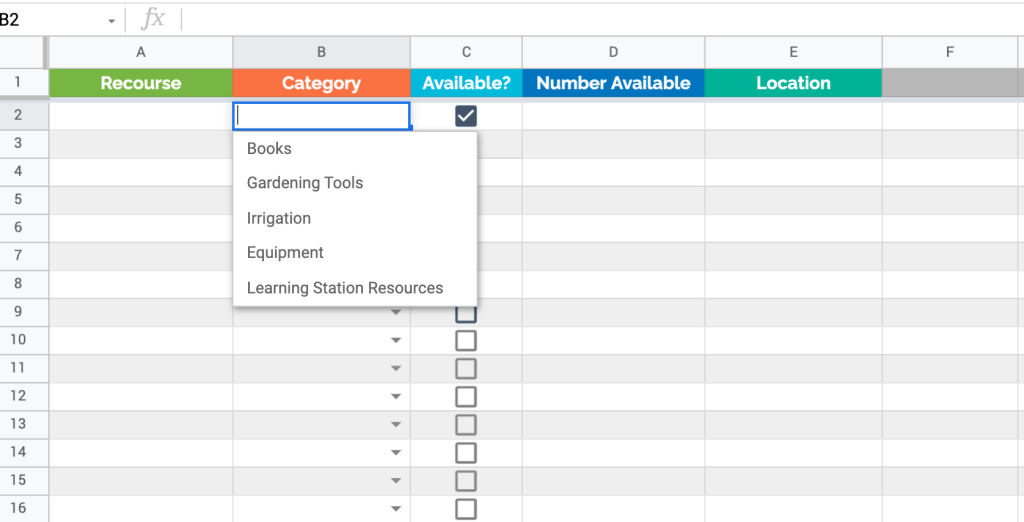
15. Books inventory tracker template in Google Sheets
One more template that can be used for multiple purposes (by libraries and bookstores or to organize home book collections, both digital and paper) is a book inventory template. We’ve already listed some popular book categories, but you can easily add some more if you need to. And, if you plan to use the template for personal purposes, it is simple to delete unnecessary columns.
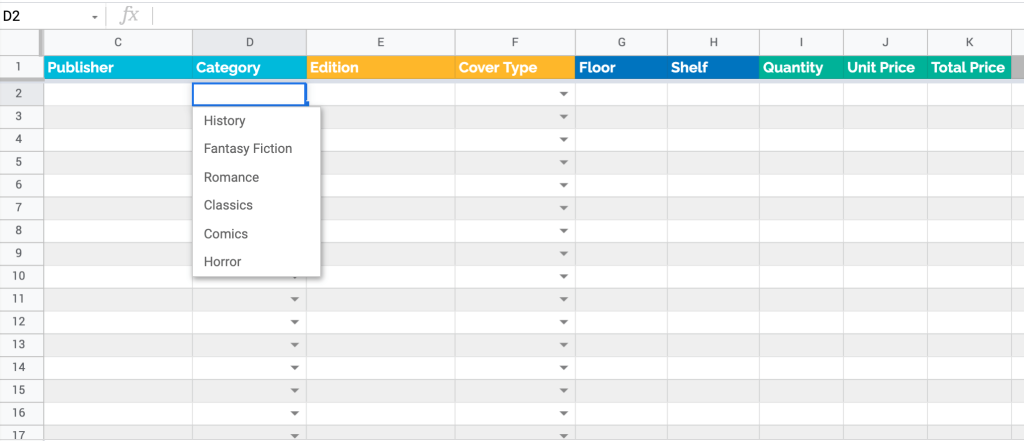
Bonus – how to create a small business inventory report for your Shopify store
If you run your small ecommerce business using Shopify, you can create a custom inventory report in Google Sheets using Coupler.io. It’s a reporting automation and analytics platform to turn raw data into simple reports. Coupler.io supports 60+ data sources and 10+ destinations including spreadsheets, data warehouses, and BI tools.
You can easily collect data from Shopify, organize it on the go, and load it to Google Sheets. It takes three simple steps and looks as follows:
1. Collect inventory data from Shopify
Click Proceed in the form below and get started with Coupler.io for free (no payment details are required).
Connect your Shopify account, and select a data entity to export.
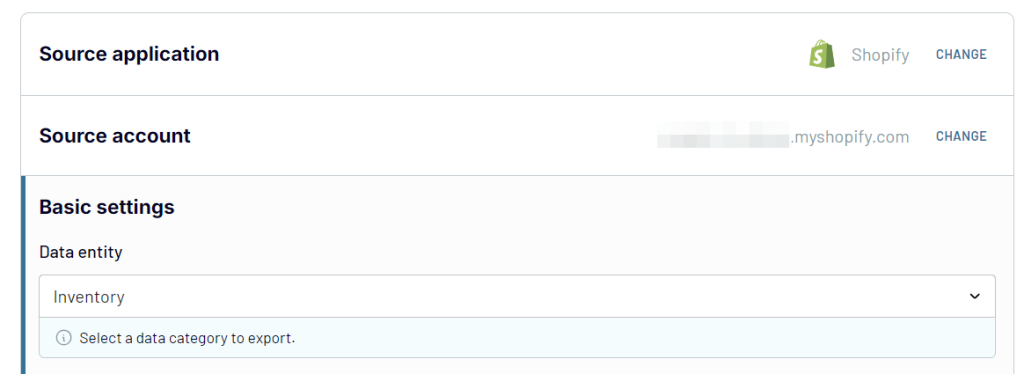
2. Collect inventory data from Shopify
At this step, you’ll get your Shopify inventory data for preview and transformation. You can:
- Hide unnecessary columns
- Edit column names and order
- Filter and sort data
- Add custom columns
Here is the simple inventory report that we’ve got.
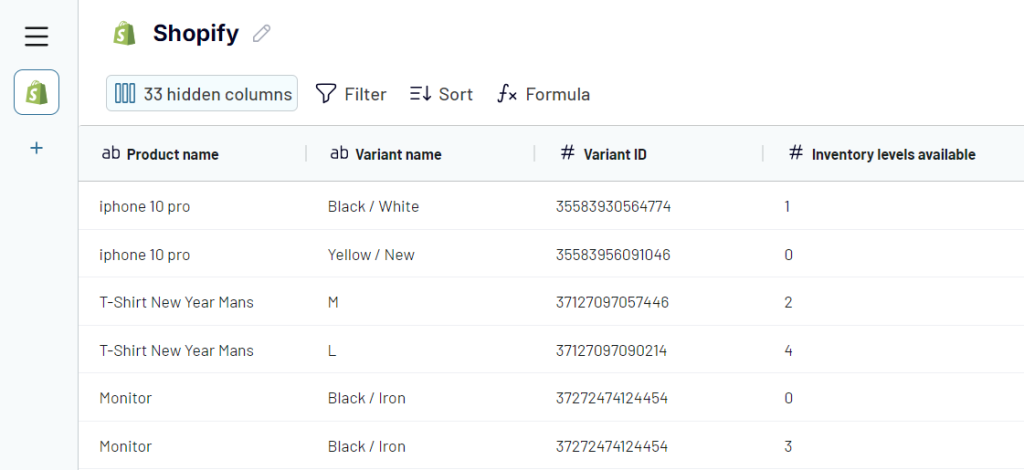
3. Load data to Google Sheets and schedule refresh
Follow the destination setup instructions to connect your Google account and specify the spreadsheet and a sheet to load inventory data.
The last thing to do is to enable the Automatic data refresh and configure the schedule.

Here is the result

In addition to creating custom reports, Coupler.io also offers a number of dashboard templates for marketing, PPC, CRM, sales, and so on.
Try it right away to automate your reporting needs in Google Sheets and beyond.
What is the value of inventory management for your business health?
What is “inventory management”? Put simply, it means tracking your store’s inventory, listing all of your products and product-related info, and logging whenever anything’s added or taken out.
Inventory management aims to keep the balance between maintaining the right amount of inventory to satisfy your customer and cost reduction. These two aspects often conflict with each other. To keep your customers satisfied and ensure fast delivery, you may need to hold on to extra inventory. No business wants to miss a sale because of a lack of inventory. However, inventory is an investment that requires substantial financial inflow and makes it impossible to keep costs down. Also, you not only spend money purchasing the materials, parts, and components but to store and manage all that material.
Therefore, it is so important to keep all your inventory organized and tracked.
Why use Google Sheets for inventory management templates?
Most big e-commerce operators and retailers use dedicated inventory management software to plan, coordinate, and control every aspect of their inventory. But, for a small business, it is actually an unnecessary luxury, and Google Sheets is a great starting point to start tracking your products, profits, and needs at little or no cost.
Google Sheets is a customizable and cloud-based tool that can be easily used by multiple team members. Of course, it has some limitations as well. For example, you need to make manual entries and can’t scan QR codes and barcodes, unlike more sophisticated inventory management software. But with some add-ons or tools, like Coupler.io, even these limitations can be tackled.
Updating your database every time a new product is added or an order is placed, and recording every transaction and shipment is a tedious task, let’s face it.
Well, ready-to-use inventory templates can’t make it fun for you (though there is some hidden beauty in all those tables and numbers), but they can definitely make your life easier. This will remove the need to Google how to create one on your own.
What data should an inventory template contain?
An inventory template usually includes the following items:
- SKU number
- Barcode
- Name
- Serial number
- Description
- Location
- Cost per unit
- Quantity in stock
- Sale price
- Minimum order quantity
- Order time
- Supplier
- Total cost
This list may vary depending on your business’s needs. Some of the headings may be excluded, and some may be added. For example, you may also want to track expiration dates, add customized notes, pictures, videos, links, etc.
If you wish, you can include formulas and calculations in your spreadsheet, or you can create a workbook with interdependent spreadsheets, or tabs, each displaying different calculations. You may want to know:
- Quantity in stock
- Purchase costs
- Inventory value
- Quantity to reorder
- etc.
Do inventory templates for Google Sheets make our lives easier?
If you ask us, our answer would definitely be yes. No matter what the type and size of your business is, there’s no reason to rely on manual methods anymore, and spreadsheets seem to be a simple and flexible tool for tracking and managing inventory. Google Sheets inventory templates in their turn can be a great starting point for that and a perfect source of ideas.
Commonly defined, inventory is an asset of a company. According to lean principles, inventory belongs to one of the seven wastes and should be eliminated. Contradictory? Well, Taiichi Ohno, the father of lean manufacturing, expressed this best when he said, “The more inventory a company has, the less likely it is they will have what they need.” He means that the only inventory of value is the inventory needed to meet demand, and the rest must be reduced so that you can manage the remaining inventory as an asset.
Hence, whatever you call inventory, one thing is clear: an inventory should be well managed. A strong grasp of inventory helps reduce headaches related to over- and under-stocking and ensures the financial and operational stability of your business.
Automate reporting in Google Sheets with Coupler.io
Get started for free


